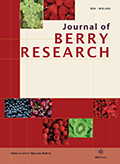Authors: Kosińska-Cagnazzo, Agnieszka | Weber, Brian | Chablais, Romain | Vouillamoz, José F. | Molnár, Bence | Crovadore, Julien | Lefort, François | Andlauer, Wilfried
Article Type:
Research Article
Abstract:
BACKGROUND: Goji berries, traditionally used in Chinese medicine, are nowadays gaining popularity in the Western world. The efforts are made to establish their cultivation in Europe. Goji berries might derive from two closely related species: Lycium barbarum and Lycium chinense, however, plant species is rarely stated by commercial suppliers. OBJECTIVE: The aim of this study was to evaluate the antioxidant activity and the bioactive compounds profile of fruits from six goji berries cultivars cultivated in Switzerland and to provide their genetic characterisation. METHODS: Goji fruits were cultivated at the experimental field of the Agroscope
…Research Center in Wallis, Switzerland. The genetic characterization was carried out by amplifying and sequencing two nuclear genes and one chloroplastic gene. The comparison with L. barbarum and L. chinense obtained from the Conservatory and Botanical Garden of Geneva (CBGG) was made. The profile of carotenoids and polyphenols was analysed using an HPLC-DAD. The antioxidant capacity was determined by ORAC and TEAC assays. RESULTS: DNA sequencing and phylogenetics confirmed that all the cultivars belonged to the Lycium genus. ‘Tibet’, ‘Red Life’, ‘Sweet Lifeberry’, ‘Big Lifeberry’ seemed to be closely related to a L. barbarum , whereas ‘Number One’ segregated closer to L. chinense . The individual Saxon , appeared genetically different from all other cultivars and the L. barbarum and L. chinense individuals from CBGG. Zeaxanthin esters were the predominant carotenoid in all six cultivars. ’Number One’ had the highest content of phenolic compounds such as rutin and ferulic, chlorogenic, caffeic and p -coumaric acid. CONCLUSIONS: The study confirmed the importance of combining the quantification of bioactive compounds with genetic characterisation in the analysis of goji species. The dissimilarity of ‘Number One’ and Saxon from four remaining cultivars investigated in this study was evident from the DNA sequencing and Principal Component Analysis of chemical results.
Show more
Keywords: Goji berries, genetic characterisation, polyphenols, carotenoids, zeaxanthin dipalmitate, antioxidant activity, HPLC-DAD
DOI: 10.3233/JBR-160144
Citation: Journal of Berry Research,
vol. 7, no. 1, pp. 43-59, 2017





